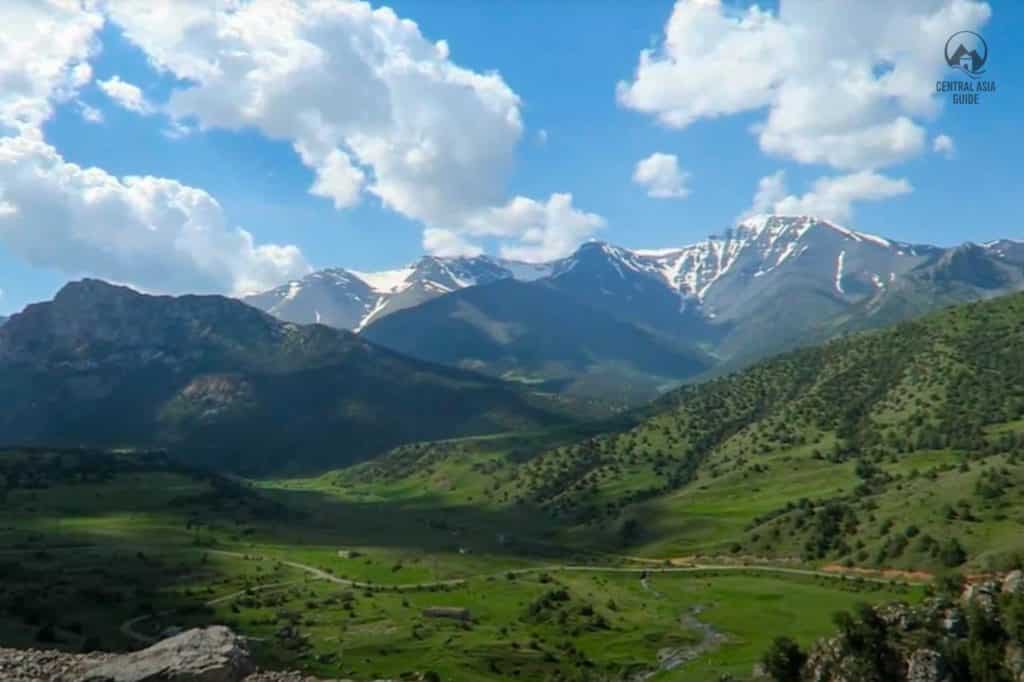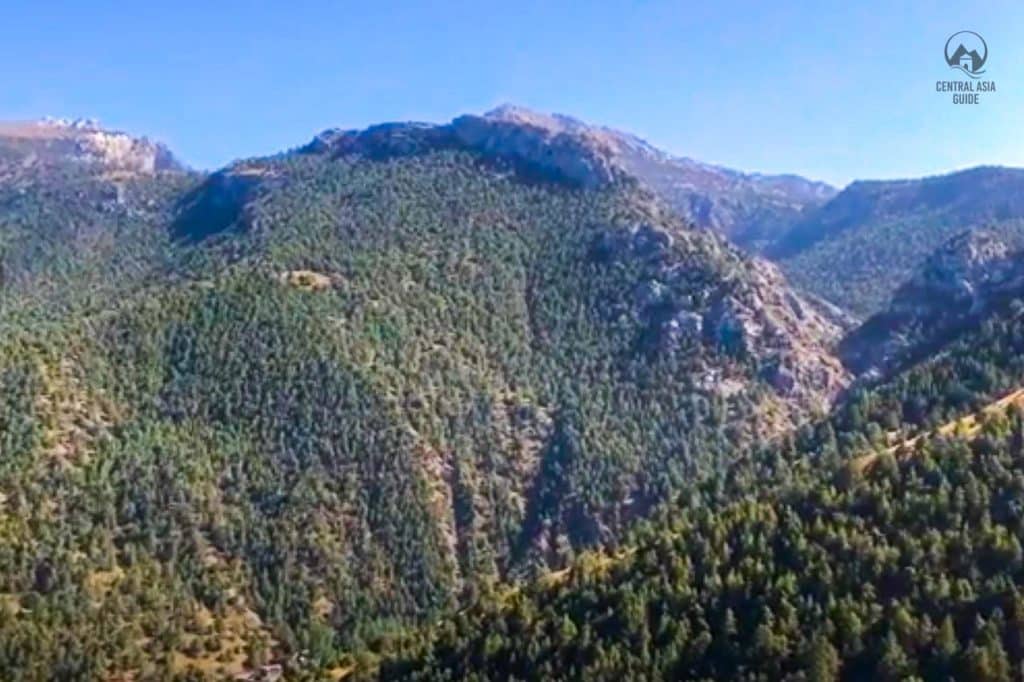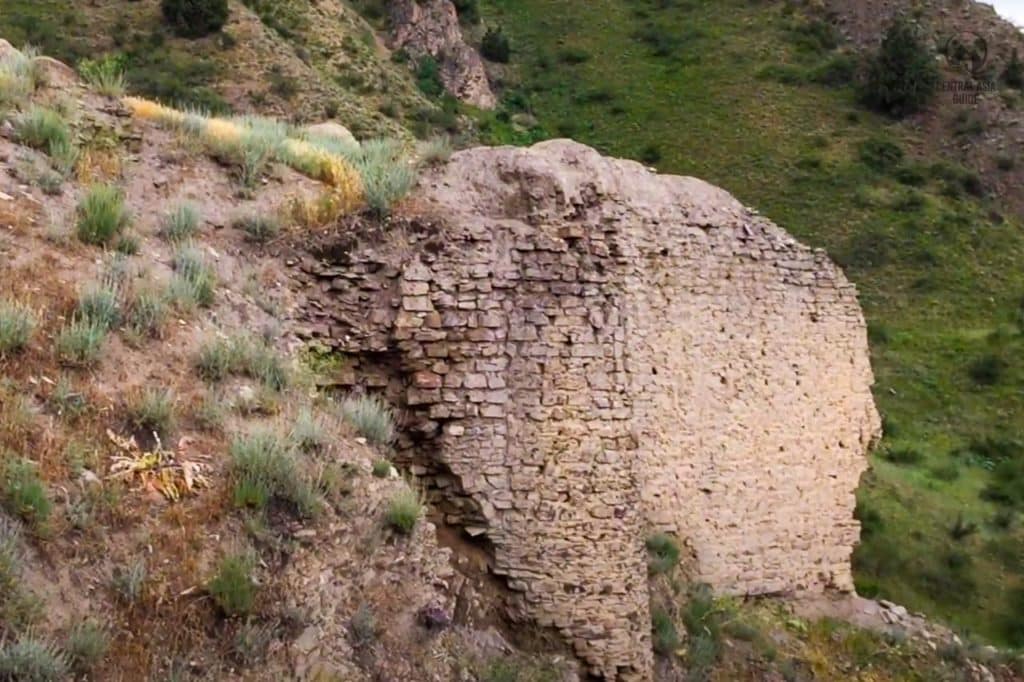Zaamin National Park
Zaamin National Park
Zaamin National Park is a place of majestic snow topped mountains, dense coniferous forests, the purest air filled with the smell of mountain herbs and beautiful flowers. In Uzbekistan they call it “A paradise of Uzbekistan” or the “Uzbek Switzerland” due to its pure beautiful nature. Zaamin is truly different from everything that Uzbekistan offers and reminds more the desolate mountain regions of Kyrgyzstan and Tajikistan and is actually bordering the latter one. There is a small entrance fee to enter the park.
The Zaamin national park is located 25 km south from the village of Zaamin and 55 km south south-east from Jizzakh in the north and about 159 km east from Samarkand, making it a possible day trip from there. The word ”zaamin” is translated from Tajik as ”agricultural land”, because from the old days this area was known for its fertile soil. The National Park shouldn’t be confused with the Zaamin Reserve, which is located quite near the national park. The reserve carrying the same name, however, doesn’t allow visitors inside and any economic activity is prohibited in the area. The park was founded already in 1926 being the oldest one in Uzbekistan and covers an area of 24 110 hectares.


Zaamin area is believed being one of the most ancient human inhabited regions of Central Asia. Ustrushana dynasty, located between the ancient regions: Sogd, Bactria, Fergana and Chach, ruled here from the ancient times. According to archaeological sources, the age of Zaamin’s dwellings are more than 2500 years old and ancient cities like Panjakent and Istaravshan are not far away.
Large area of the reserve is occupied by forests as well as mountains with deep gorges and hilly terrain. The biggest mountain in the park is called “Shaukartu mountain” with 4 kilometers height. Zaamin Park is particularly beautiful during the spring and autumn time. From April to May you can meet a large amount of locals here having picnics and wandering in the nature. The choice of accommodation in Zaamin pretty small since tourism hasn’t reached it much yet. There are nevertheless several guest houses in villages outside the park and a couple of mini-hotels on the territory. The best sights of Zaamin for tourists/expats are off the beaten path attractions found by hiking.
Zaamin Flora and Fauna
There are about 800 different species of plants in Zaamin area, among them a large number of medicinal plants like bindweed and Turkestan hawthorn, geranium, carnation and tarragon. Oldest juniper trees in the park are hundreds or event thousands of years old and unique juniper thickets can be found by hiking. Growing together in groups, in some places they turn into a real thick jungle.
The fauna includes many rare animals distributed among different mountainous habitats. Wolves and snakes roam the mountain-steppe zone, and owls, blackbirds, turtledoves and owls roam the airy expanses of the forest. The forest is often home to formidable predators – white-clawed bears and the Turkestan lynx. There are even reports of sightings of snow leopards in the park.
Zaamin attractions, sights & destinations
Zaamin Sanatorium
Zaamin sanatorium is surrounded by mountains from all around and feels like a bowl when standing in the valley. Most of the walls of this bowl are covered with junipers or other coniferous trees and cut by several streams and tributaries of the Uriklisai gorge. The sanatorium is located at an altitude of 2000 meters above sea level and the houses for and campsites for tourists are just a little below the sanatorium.
Zaamin sanatorium is a usual Soviet-style sanatorium that was built in 1970s for lung patients and has a very futuristic architecture. It is thought that the park around the sanatorium has curative air due to the mountain juniper forests. The territory of the sanatorium is fairly busy as it is filled with a herbs market selling honey and lamb baked in tandoor together with some cafes. There is also a small slope for skiing near the sanatorium.


In addition to the Soviet technology, the sanatorium has also modern medical equipment including departments for electrocardiogram, ultrasound and dentistry. There are two swimming pools, a sauna, as well as massage services, mud treatment, treatment with sodium-chlorine salt, inhalation equipment and more.
Zaamin Reservoir
Before the entrance to the park from the northern road of the park, lies Zaamin Reservoir. It is a great spot to camp or to have a picnic and swim. At the bottom of the dam lies a beautiful meadow with large spruces. If you climb up by car or foot through a steep serpentine road up the dam, you can enjoy a great reservoir view.
Sher Bulak Spring
“Sherbulok” spring is located nearby the Zaamin sanatorium. Its distinctive feature is the stream of water that flows from the stone lion’s head. The spring water is very popular for its mineral composition enriched with calcium.


Suffa Plateau & Radio Astronomy Observatory
“Suffa” International Radio Astronomy Observatory is located on the high-mountainous Suffa plateau 10 km west from the Zaamin Sanatorium and 200 km southeast of Tashkent at the altitude of 2500 m above sea level. Construction began in the late ’80s but was put on hold when the Soviet Union fell. Since 2008, construction had resumed, with modernized equipment for millimeter-wave band observations. With its 70 m antenna diameter, this third unit of the RT-70 telescope design will be among the largest single-dish radio telescopes in the world.
Peshagar Cave
The cave is located in a deep mountain valley of the Peshagar gorge which belongs to the Zaaman district and is actually not inside the national park area.
The cave “Peshagar” has become a popular spot for visitors after the discovery of ancient findings in it, among which were found various daily objects of primitive man, as well as ancient petroglyphs: rock paintings that illustrate the way of life of an ancient man with hunting scenes and other intentions.
Sharilak Waterfall
Sharilak waterfall is located near the Zaamin sanatorium at the head of the Uryuklisai gorge. A powerful stream of water passes down into the brook that is located next to the former dacha of Rashidov from the height of about 100 meters.
Rashidov was a Communist Party leader in the Uzbek Soviet Socialist Republic and a CPSU Central Committee Politbureau candidate member between 1961 and 1983.


Marifatli Mosque
Marifatli mosque is located in the village of Zaamin, north of the Zaamin National Park. In 2018 this mosque from the 15th century was restored. Today the mosque occupied a larger space and holds about 6,000 believers. The mosque even has its own attraction, an ancient mulberry tree. This tree is assumed to be over 1000 years old.
Zaamin Local Lore Museum
The museum contains over four thousand exhibits of ceramics used in everyday life in the 17th-18th centuries, numismatics, jewelry, household items, national clothes for women and other items.
Kyrk Kyz Stones
Of the natural monuments in Zaamin exist the giant red stones, they lie in the Kyzyl-Ataksay glade, and in translation from the local language they are called “forty virgins” or “forty girls”.
"Boboengok" Nut Tree
There is an ancient nut tree called “Boboengok growing in the Zaamin National Park with an estimated age of 700 years. Its height is 20 m, the crown width is 28 m, and the trunk diameter is 2,7 m. “Boboengok” means “grandpa nut”.


Fortress Myk
Ancient Fortress Myk (or Mok) is located deep in the scenic canyon of Chortagna, in the headwaters of the Yettikachi river. The ruins of the fortress are at the altitude of about 2000 m and consist of four objects called Myk I, II, III and IV. Ruins fill the top of a natural rocky cliff at an altitude of 80 meters above the valley level. The structures are artificially tied to the terrain and were a powerful stronghold, controlling the entire surrounding area. This once-legendary fortress, dated between 6th to 11th centuries AD, was part of the Ustrushan Kingdom which was a very important mining and metallurgical region of its time, as evidenced by numerous mines and slag outlets around the fortress. For more than 500 years of its existence, the fortress had been repeatedly destroyed, plundered and burnt.
Sources from the 10th century indicate that in Ustrushana, iron was produced in the “Mink province and in the city of Mirasmand”. Their location is still controversial and remains a pertinent issue due to their outstanding role in the history of Central Asia and to their involvement in the global events that unfolded in the Near and Middle East at the time of the emergence and spread of Islam. Archaeological studies in the mountains of Western Ustrushana exposed an entire system of ironworks and specialized settlements. The largest one, Myk is a unique complex that consists of two castles and an industrial settlement. The chronology of the materials from the site, and their comparison with the data from written sources of the 9th-10th AD, allow identifying Myk mining and metallurgical zone with the province of Mink, and the successive castles of Myk with the Afshin’s fortress.
According to historical data, the fortress Muk I stood until the beginning of the 8th century. The traces of the fire in the castle testify its violent destruction most likely related with the Arab campaigns to Central Asia. After falling, Muk I was never inhabited again, its ceilings collapsed and the walls remained unrepaired. By the middle of the 11th century, when the tough times came for Central Asia, increased by outbreaks of internecine wars among the numerous Karakhanid rulers affected the distant fortress of Myk as well. The artifacts found here include utensils thrown to the floor of the village of Muk III, enormous conflagration in the fortress, abandoned expensive utensils, tools and human bones that visually match the scale and character of the disaster that once happened here.
The remains of the settlement lived on until in the first half of the 11th century, when during the second half of the century, life improved here, however to a much more minor extent than it used to be. In 1141, occurred the second wave of the difficult period for Myk, when the hordes of Karakitay invading Maveranahr defeated Sultan Sandjar’s army and the fortress was located in the rear of the conquerors. By the middle of the 12th, the fortress was completely empty. Existing only for five centuries, the fortress became a silent witness of bloody battles, the rise and fall of local states.
The Myk fortress area is located west – northwest from Zaamin sanatorium. It can be reached easiest from north by a small road that separates to a western gorge from the main road leading to Zaamin sanatorium after the reservoir.

Other destinations and sights near Zaamin
Page updated 28.1.2023